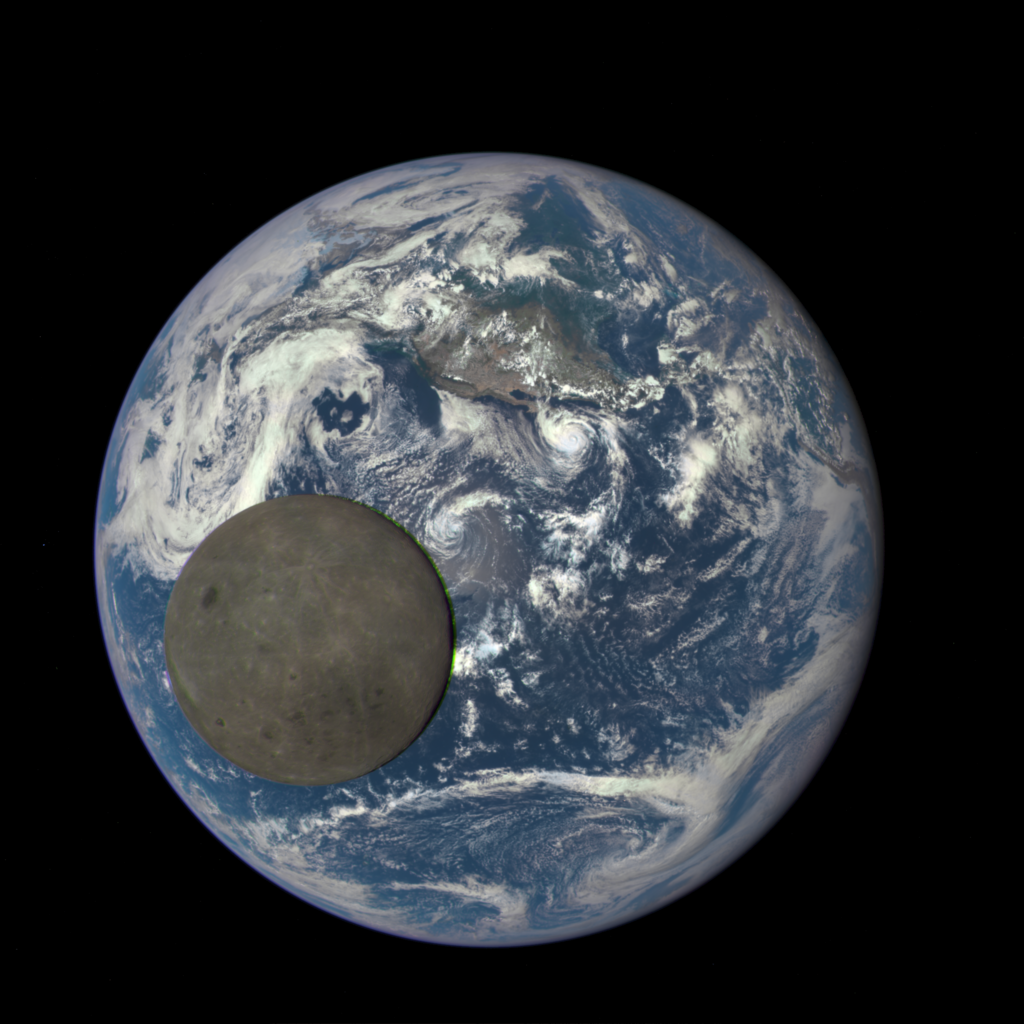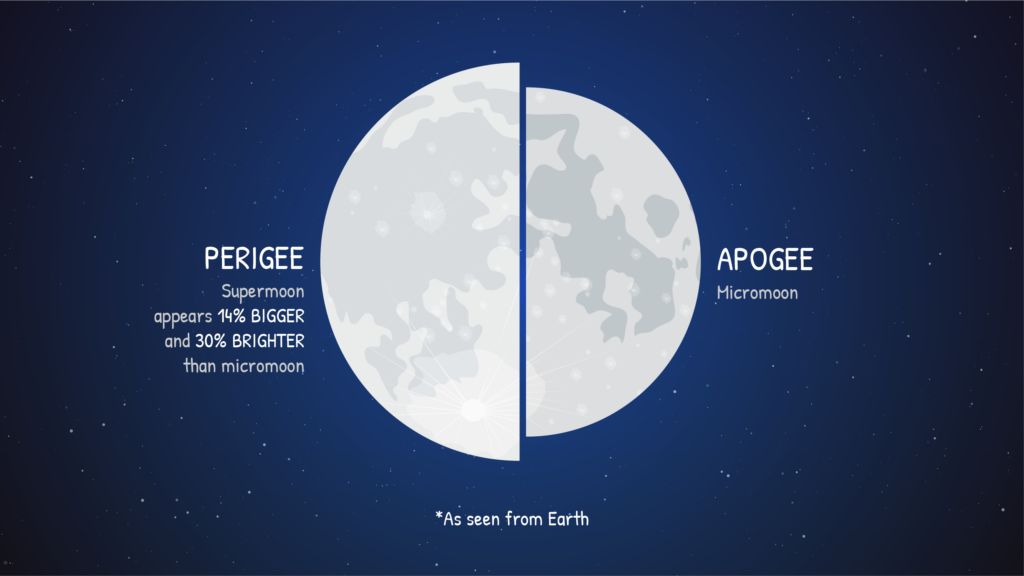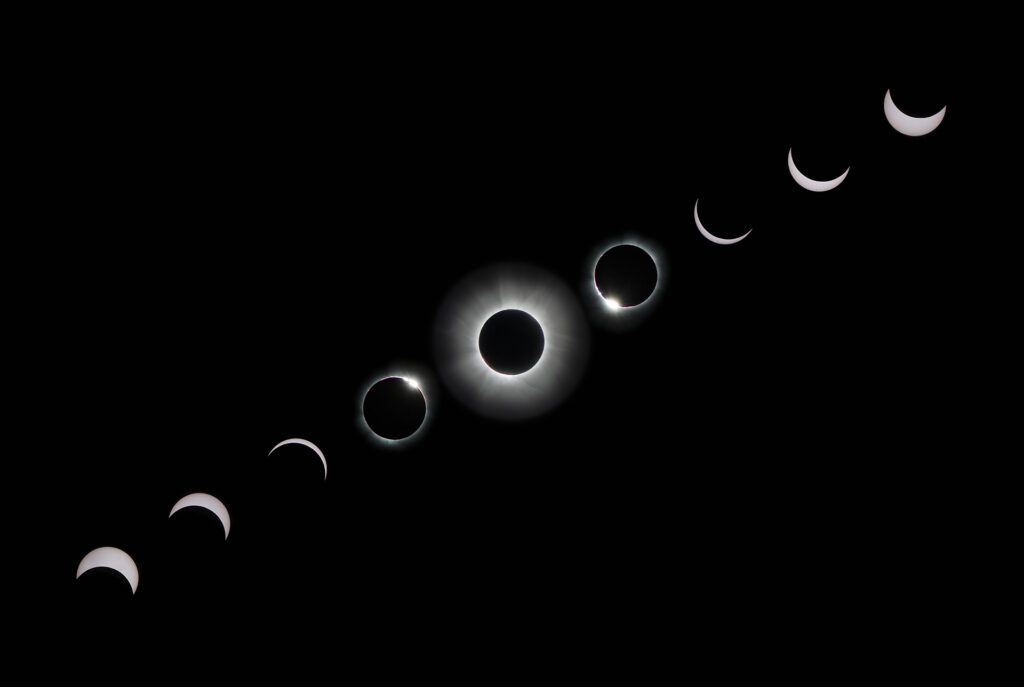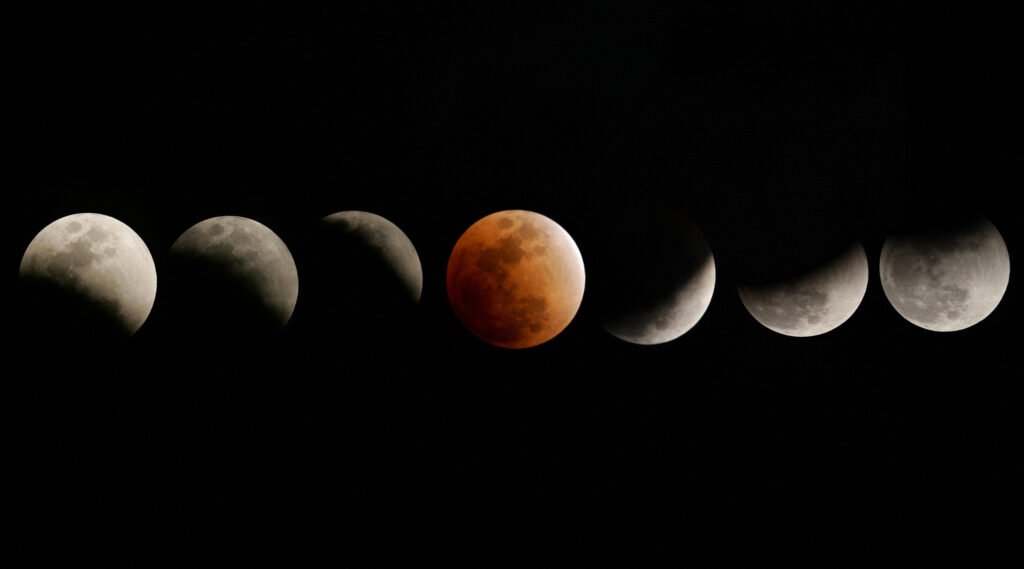From time to time, media burst with exciting headlines like “Today there will be a supermoon!” or “Tomorrow we will be able to see a supereclipse!”. But are these exclamation marks and prefix “super” appropriate? What is really behind these events? Should we be afraid of them, or, on the contrary, be happy about them? Let’s muse on these questions.
An unstable orbit
The Moon orbits the Earth in an elliptical orbit. Why elliptical? In fact, all bodies that constantly revolve around more massive bodies move in more or less elongated ellipses. The degree of elongation of the ellipse is measured by eccentricity which is the ratio of the maximum deviation of the distance between the bodies from the average value to the average value itself (in celestial mechanics it is called “the major axis of the orbit”). A circular orbit can be considered a kind of ellipse with an eccentricity of exactly zero. But, firstly, absolute precision is extremely rare in nature. And secondly, all massive objects are in constant gravitational interaction, continuously changing each other’s orbital elements. Therefore, even if someone’s eccentricity accidentally “zeroes out,” such a state lasts for a very short time in cosmological terms.

A good illustration of the last point is the “Earth-Moon” system. The average distance between these bodies (more precisely, between their centers of mass) is 385,000 km. The eccentricity of the lunar orbit is 0.0549. This means that during each of its revolutions, our natural satellite reaches perigee, approaching us at a distance of 363,230 km. But no one calls such an approach a “supermoon” because otherwise, we would see this term in newspaper headlines every month.
In reality, not only the Earth but also the Sun has a huge influence on the Moon’s motion (paradoxically, it attracts the Moon almost twice as strongly as our planet does). Therefore, the value of the lunar perigee can vary from 356,000 to 370,000 km. Here it would be appropriate to add “in our time” because over longer periods, this interval is even greater. So, every year, it is possible to determine the moment when the Moon comes closest to us. In 2020, the “supermoon” perigee was observed on April 7 at a distance of 356,908 km.
Could this be noticed with the naked eye? Maybe, if you look very carefully. The diameter of the lunar disk at “superperigee” is approximately 6% larger than the average value and, accordingly, 13% larger than at “superapogee” (when our satellite is farthest from us). There is one technically straightforward way to see this for sure: you need to select such a magnification of an astronomical instrument that the Moon occupies almost the entire field of view. Then all variations in its size will become obvious.

Of course, history does not end with this year alone. Even in not so distant times, our satellite approached (or will approach) us even closer. For example, in the 21st century, the record lunar perigee will occur on December 6, 2052, when the Moon will be at a distance of 356,429 km from us. In the last century, there were even closer “flybys”: for example, on January 4, 1912, our satellite approached the Earth at a distance of 356,375 km. In the future, this “closest approach record” will only increase, as the major axis of the lunar orbit increases by an average of 38 mm per year. We will explain the reason for this increase below.
Catch the Tidal Wave!
An even more interesting situation arises when the lunar perigee coincides with the new or full Moon phase (since, as mentioned earlier, nothing is absolutely accurate in nature, in this case, the “coincidence” is considered the difference between the moment of perigee and the corresponding lunar phase is not more than 12 hours). In the latter case, we will deal with the so-called supermoon eclipse, when the Earth-facing hemisphere of our satellite is not only illuminated by the Sun to the greatest extent but it is also closest to us. And since the intensity of the light flux reflected by the Moon and reaching our planet is inversely proportional to the square of the distance of the “reflector,” such a full moon will look 16% brighter than the average.”

However, the new Moon in perigee also has its peculiarities, well-known to sailors and port workers, for instance. The point is that the gravitational force on opposite points of the Earth’s surface (“sublunar” and “antilunar”) noticeably differs, causing a certain additional “stretching” force directed along the line towards the attracting body. The Earth’s atmospheric and aquatic shells respond most readily to these forces, a phenomenon noticed by inhabitants of coastal areas since ancient times (especially along ocean coastlines). Every day, the Moon causes the water level to rise and fall, creating tides, and this gravitational influence is called tidal forces. They are inversely proportional not to the square but to the cube of the distance from the body that is their source, making them particularly sensitive to the position of our satellite in its orbit.
However, there is another important body in the Solar System that creates tidal forces, and we have already mentioned it. It is our Sun. Although it is about 400 times farther from us than the Moon, it has a mass about 27 million times greater, so the tidal waves created by it are, on average, only about twice as weak as the lunar ones. When the Sun, Earth, and Moon are approximately aligned (this happens during the new and full Moon phases), solar and lunar tides reinforce each other. And when our natural satellite is also in perigee at this time, one can expect real super-tides, nearly three times more powerful than the average ones. They are sometimes used for navigating shallow channels with high draft ships or for beaching old ships that are going to be scrapped.
Of course, the Earth does not remain in debt and, in turn, creates tides on the Moon, which have long since stopped its rotation around its own axis (more precisely, synchronized it with its orbital motion) and made it “look” at us with the same side. Interestingly, due to tidal interaction, the energy of the axial rotation of our planet is gradually transferred to our satellite, “raising” its orbit by the aforementioned 38 mm per year. As a result, the Earth’s day increases by an average of 17 microseconds each year — more precisely, it should increase by 23 μs, but it is additionally “accelerated” by 6 μs due to the gradual gravitational compression of equatorial regions.
Records of the lunar shadow
So far, we have mainly mentioned the full Moon and ignored the new Moon because it is most difficult to observe this phase: during it, the “night luminary” is near the Sun in the sky. But even during this phase, it can be seen from time to time – if it partially or completely covers the solar disk during an eclipse. Such events occur not so rarely (from 2 to 5 times a year), but each of them is visible only in a limited area on Earth.

The Earth’s orbit is not as elongated as the Moon’s orbit (its eccentricity is 0.0167), so the difference between the largest and smallest apparent diameter of the Sun only slightly exceeds 3%. But if we take the average values of the sizes of the solar and lunar disks, the latter turns out to be smaller (also by about 3%), and even during the maximum eclipse, there is a dazzling “solar ring” around it, Such eclipses are called annular. It is easy to understand that they occur more often than total eclipses. Unfortunately, their observations have little scientific value: during them, the sky remains too bright, making it difficult to see the solar corona – the outer atmosphere of the luminary, the study of which provides us with a lot of important information about “space weather” and solar-terrestrial relations.
In fact, during annular eclipses, one cannot speak of the lunar shadow — all observers find themselves inside the lunar half-shadow (penumbra), but for the territory where the “solar ring” is visible, a special Latin term “antumbra” is used. The simple geometric construction makes it possible to understand that its size is the larger, the farther the Moon is from the Earth, that is, the closer it is to its apogee. Since in apogee, the orbital speed of our satellite is the slowest, with the presence of additional “aggravating circumstances” — the Earth’s passage through perihelion (that is, the largest apparent diameter of the Sun) — we get real records of eclipse duration: for example, on January 15, 2010, the maximum duration of the annular phase was 11 minutes 11 seconds. It was observed in the Indian Ocean near the Maldives. An even longer eclipse occurred on January 4, 1992 – 11 minutes 41 seconds (it reached its maximum in the Pacific Ocean). This record will last until the beginning of the fourth millennium – until 3043.

What about total eclipses? Clearly, during them, the Moon must be as close as possible to the perigee of its orbit. However, at this point, its speed of movement is the highest, and the lunar shadow “passes” over the observer more quickly. But with a decrease in the distance to our satellite, the diameter of the “spot” of its shadow (and, accordingly, the width of the total phase strip) increases more noticeably than its speed. If the observer is fortunate enough to be near the equator, he can observe the eclipse even longer because the Moon’s own speed, determined by the Earth’s rotation around its axis, significantly prolongs its stay in the shadow zone. Therefore, the necessary conditions for a long duration of a total eclipse can be formulated as follows: it should occur at the end of June or the first half of July (when the Earth is farthest from the Sun and the diameter of the solar disk is smallest), the Moon should pass through the perigee of its orbit, and the strip of the total phase should be located not far from the Earth’s equator.
During the 21st century, there will be no such rare coincidence of circumstances even once. The “closest to ideal” eclipse turned out to be the one on July 22, 2009, with the total phase duration of 6 minutes 39 seconds. The record of the last century was noticeably longer (June 20, 1955, 7 minutes 8 seconds). And on July 16, 2186, over South America and the Central Atlantic, the solar corona will shine for 7 minutes 29 seconds. This is the longest duration of a total eclipse in the time interval from 4000 BC to 6000 AD.
The last total solar eclipse observed on the territory of present-day Ukraine was on February 15, 1961, and the next one will not happen until April 20, 2061, and it will be visible low above the horizon only in the southeastern part of the Luhansk region. As for annular eclipses, the situation is slightly better: the closest one will occur in Crimea and in the south of the Donetsk region on the morning of June 1, 2030. There, the Moon will cover 94% of the diameter of the solar disk. Residents of Kyiv will see the maximum partial phase of 82%, while those in Dnipro and Odesa will see 89%.

Lastly, it’s worth mentioning lunar eclipses. Although they occur less frequently than solar eclipses, they are observed from a whole hemisphere of the Earth where our natural satellite is above the horizon. It is easy to understand that their duration will be the longest during Earth’s aphelion (in June-July when the diameter of the Earth’s shadow cone and its length reach a maximum) and lunar apogee (when the orbital speed of our satellite is the slowest). The record eclipse of the 21st century happened two years ago on July 27, 2018 when the Moon was completely immersed in the shadow of our planet for 103 minutes (1 hour 43 minutes). For the eclipse on June 9, 2123, calculations predict a total phase duration of 106 minutes. As time goes on, this record will only continue to grow.
